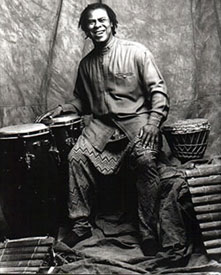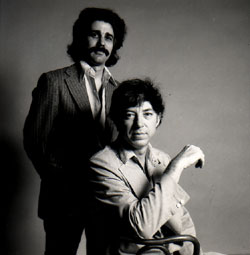

|
Soundclip:
|
| See Steve's Hand-Written Lead sheet |
Steve Khan's Lead sheet:
"In a Star's Arms"(Khan) When entrepreneur George Braun presented me with opportunity to do the music for a digitally animated commercial for Tokyo Gas & Electric featuring the artwork of Jean-Michel Folon, it was a most easy decision to make. After accepting, I was asked to present a variety of music from my recorded catalog and the ad agency would select three pieces of music. The assignment was to compose new pieces which might loosely resemble those which had been selected. After some time had passed, I was informed that they had chosen "Tafiya" and "The Blue Rose" from "LOCAL COLOR" CD with Rob Mounsey and, "Candles" from the "ARROWS" recording.  And so, "In a Star's Arms" was born as a brand new "free ballad" in the style of "The Blue Rose." Of the three new pieces of music, this was the easiest to compose and record. I decided to call upon two very talented musicians and dear friends: Clifford Carter to do all the keyboard work, and the fantastic Brazilian percussionist Café would join us as well. These two players were the only two to appear on all three new compositions, and their performances remain as wonderful. And so, "In a Star's Arms" was born as a brand new "free ballad" in the style of "The Blue Rose." Of the three new pieces of music, this was the easiest to compose and record. I decided to call upon two very talented musicians and dear friends: Clifford Carter to do all the keyboard work, and the fantastic Brazilian percussionist Café would join us as well. These two players were the only two to appear on all three new compositions, and their performances remain as wonderful.While preparing for the recording, Clifford and I were able to get together a couple of times beforehand because, in those years, we were neighbors, both living on W. 21st St. in New York City. The recording session took place on July 15th, 1987 at RPM Studios with engineer, Kevin Halpin behind the console. While listening to this piece, for the first time in many years, I was a bit uncertain as to just which acoustic guitar I had played, but now I am certain that it was my Martin MC-28. My original sunburst model had been stolen out of the Weather Update equipment Ryder Truck in Chicago during 1986. So, this guitar, which I still have and use to this day, was the replacement, graciously provided with the assistance of John Marshall from Martin Guitars in Pennsylvania.  Clifford Carter was to play acoustic piano which was to have been Midi'ed to an orchestral 'string' patch. I don't recall whether or not we had the capability to do that, or if we just used a 'sample' of an acoustic piano and did it that way. Café's presence is most special to everything. Not only does he add his own unique percussive touches, but because he has such a warm and rich speaking voice, I called upon him to say a few words in his native Portuguese, which would express something about the "environmentally friendly" posture of Tokyo Gas through these commercials. The intent throughout was to show a concern for our planet and our deteriorating environment. So, though my knowledge of Portuguese is extremely limited, I know that I can hear the words "peace" and "love" in there somewhere. Clifford Carter was to play acoustic piano which was to have been Midi'ed to an orchestral 'string' patch. I don't recall whether or not we had the capability to do that, or if we just used a 'sample' of an acoustic piano and did it that way. Café's presence is most special to everything. Not only does he add his own unique percussive touches, but because he has such a warm and rich speaking voice, I called upon him to say a few words in his native Portuguese, which would express something about the "environmentally friendly" posture of Tokyo Gas through these commercials. The intent throughout was to show a concern for our planet and our deteriorating environment. So, though my knowledge of Portuguese is extremely limited, I know that I can hear the words "peace" and "love" in there somewhere.Like "The Blue Rose," "In a Star's Arms" is performed almost totally in "rubato," out of time. However, you will notice that there is just the slightest hint of tempo when we play at letter [B]. The form of the piece also resembles "The Blue Rose" except, for this performance, we only go through the form three times. During the initial statement of letters [A] and [B] the acoustic guitar concentrates on the melody, while Clifford Carter's acoustic piano provides the harmony, and then answers and improvises around the melodic fragments. The first appearance of the voice of Café occurs at the Bmaj9(6) chord which is the fourth chord to appear on system 2 of the mini-score.  His monologue continues through
[B] until the C7(9b5) chord arrives. The 2nd Chorus of the piece is for the guitar improvisation. The 3rd and final Chorus features a return to the melody but, this time, the guitar, after stating each melodic fragment, improvises around it. When we arrive, for the final time, at system 4 and the F#m7(9)/B, I play a pick-up which leads us into the [Tag]. It is a sequence of three chords which offer a finality to the piece. Like "The Blue Rose," the harmonic movement of the first two chords: Cmaj7(6) to Ebmaj9(#4) is much the same. However this time, the piece rests of a minor sonority, Em9(sus), which felt more appropriate. His monologue continues through
[B] until the C7(9b5) chord arrives. The 2nd Chorus of the piece is for the guitar improvisation. The 3rd and final Chorus features a return to the melody but, this time, the guitar, after stating each melodic fragment, improvises around it. When we arrive, for the final time, at system 4 and the F#m7(9)/B, I play a pick-up which leads us into the [Tag]. It is a sequence of three chords which offer a finality to the piece. Like "The Blue Rose," the harmonic movement of the first two chords: Cmaj7(6) to Ebmaj9(#4) is much the same. However this time, the piece rests of a minor sonority, Em9(sus), which felt more appropriate.This type of composition, in my view, is always melody-driven, and the harmony reveals itself to me as a natural course of the melodic contours. It is interesting that there only appears to be two points of resolution: [1] the arrival of the aforementioned Bmaj9(6) chord in System 2, and [2] the arrival of the final chord, F#m7(9)/B. Otherwise, there is a great sense of purposeful wandering, with an occasional pedal point. The longest of those pedal points appears at [B], with an extended moment over an 'E'-pedal. It features subtle inner-voice movements during the following chords: G#/E[Emaj7#5] to Emaj7(6), where you can see that the B#[C-natural] moves up to C#. And, for the F#/E to Emaj9(6), you can see that the A# moves up to a B-natural. The is also another small pedal point moment which occurs over these three sonorities during letter [A]: Db/Eb - Eb7(b9b5) - Abmaj7(6)/Eb. From an improvisational standpoint, it might be beneficial to assign scales or modes to the various harmonic areas encountered. Over the E/F sonority, I would employ an 'F' whole-tone/half-tone diminished scale[F, G, G#, A#, B, C#, D, E]. Over the E7(#9#5) one could use the E altered dominant scale(which is the same as F melodic minor, depending upon your personal orientation)[E, F, G, G#, Bb, C, D]. For the Db/Eb(which one could have easily labeled as Bbm7/Eb) I would suggest Bb Dorian[Bb, C, Db, Eb, F, G, Ab]. The Eb7(b9b5) presents a special problem, and seems to want to have us use the Eb half-tone/whole-tone diminished scale[Eb, Fb, Gb, G, A, Bb, B, Db].  For Abmaj7(6)/Eb, I would use the C minor pentatonic[C, Eb, F, G, Bb]. For the F#7(13b5), I would suggest the G melodic minor[G, A, Bb, C, D, E, F#]. For the Bmaj9(6), I would use the D# minor pentatonic[D#, F#, G#, A#, C#]. Over the Ab2/C, I used the F minor pentatonic[F, Ab, Bb, C, Eb]. Over the 'E' pedal point at [B], I simplified everything to E Lydian[E, F#, G#, A#, B, C#, D#], though I can hear that I briefly glossed over E Lydian Augmented to acknowledge the Emaj7#5 sonority[E, F#, G#, A#, B#/C, C#, D#]. Over the C7(9b5), I would use the G melodic minor[G, A, Bb, C, D, E, F#] again. Finally, over the F#m7(9)/B, I would use F# Dorian[F#, G#, A, B, C#, D#, E], but I also employed some B7 blues language as well. For Abmaj7(6)/Eb, I would use the C minor pentatonic[C, Eb, F, G, Bb]. For the F#7(13b5), I would suggest the G melodic minor[G, A, Bb, C, D, E, F#]. For the Bmaj9(6), I would use the D# minor pentatonic[D#, F#, G#, A#, C#]. Over the Ab2/C, I used the F minor pentatonic[F, Ab, Bb, C, Eb]. Over the 'E' pedal point at [B], I simplified everything to E Lydian[E, F#, G#, A#, B, C#, D#], though I can hear that I briefly glossed over E Lydian Augmented to acknowledge the Emaj7#5 sonority[E, F#, G#, A#, B#/C, C#, D#]. Over the C7(9b5), I would use the G melodic minor[G, A, Bb, C, D, E, F#] again. Finally, over the F#m7(9)/B, I would use F# Dorian[F#, G#, A, B, C#, D#, E], but I also employed some B7 blues language as well.Doing this project, to be once again associated with Jean-Michel Folon was a great, great thrill, and an honor. His recent passing leaves a great void, and his artistic spirit will be missed the world over. However, he left us with an immense body of work, and I am hopeful that somehow it will become possible for everyone to eventually see these gorgeous animated commercials. In truth, they were among the first to ever be attempted on such a grand scale. When everything was completed, Yuki Ohmura and Polydor K.K. decided to package the three new tracks along with old Eyewitness material, and some selections from "EVIDENCE" as well. "HELPING HAND" was released in late 1987, and this is the first piece we are presenting from that recording. In closing, as we always do at this time of the year, Blaine and I would like to wish everyone all the joys of the Holiday Season, a very Merry Christmas, and a most Happy New Year as 2008 dawns. Y por supuesto, ¡Felíz Navidad y Felíz Año Nuevo!!! Wishing you all good health, happiness, and a heapin' helpin' of PEACE everywhere!!! Maybe this year?
[Photo of Clifford Carter courtesy of the James Taylor Tour
Jean-Michel Folon with Steve by Jim Houghton in 1979] |